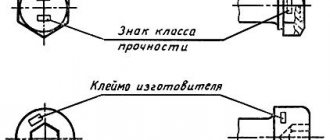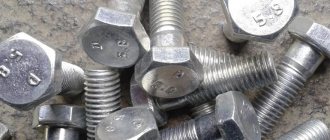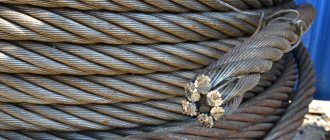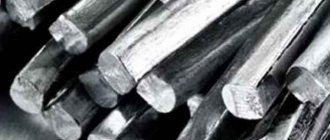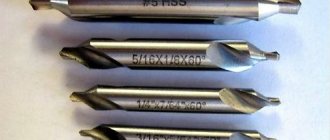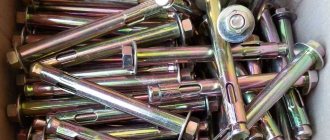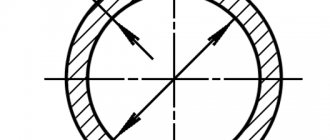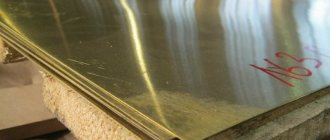The expansion anchor can rightfully be called a new generation fastener. Using such anchors made of high-strength metals, you can obtain reliable connections between elements of building structures, perform reliable fastening of large and heavy objects on various surfaces, and also solve a number of other problems related to construction, repair, installation and finishing work. Modern industry offers a wide variety of anchor-type bolts, the requirements for the parameters and characteristics of which are specified by the provisions of the relevant GOST.
There are many modifications of the expansion anchor (other names: “sleeve anchor” or “sleeve anchor”)
Installation rules
Even if you have chosen the right anchor bolt equipped with a nut, focusing on the size and weight of the object being fixed with it, incorrect installation will reduce all your efforts to nothing. There are a number of simple rules, the observance of which will allow you to provide the fastener with the required level of reliability and durability.
Anchor bolt installation steps
The installation algorithm for an anchor bolt equipped with a nut is as follows.
- It is necessary to drill a hole in the structure in which such a fastening element is to be installed. The diameter of the hole should be such that the spacer sleeve fits into it with some interference. To perform this procedure, you will need a hammer drill and a drill of the appropriate diameter.
- In order for a nut equipped with a nut to form a reliable connection, the hole in which it is installed must be thoroughly cleaned of construction dust and pieces of material crumbled during drilling. If the hole is small, then to clean it you can use a regular medical bulb and a brush of the appropriate diameter. If the hole has a significant length and a large diameter, then a vacuum cleaner can be used to clean it properly.
- Once the hole is prepared, the anchor bolt can be inserted. Although many experts recommend installing anchor bolts together with the object being fixed, there is a simpler and more effective way to perform this procedure. The nut is tightened on the anchor bolt installed in the hole until the spacer sleeve opens to such a state that the fastener is securely fixed. Then, when the anchor is securely fixed in the hole, the nut can be unscrewed from it, leaving its threaded end free to put on the object being fastened. After this, all you have to do is put a washer on the threaded end and screw on the nut.
Anchor bolt mounting mechanism
To install an anchor bolt, you will need a hammer drill, a hammer, a wrench and a drill. The mechanism for fastening the spacer bolt is quite simple; to do this, you need to do the following:
- Using a hammer drill, drill a hole where the bolt will be inserted.
- It is good to clean or blow out the finished hole.
- Insert the anchor bolt with the part into the drilled hole until it stops, if necessary, knock it out with a hammer.
- There is a groove at the top of the stud; you need to hold it with a screwdriver and tighten the bolt nut 4-5 turns.
Types of anchor bolts
The classification of anchor bolts offered by modern manufacturers is based on many parameters. They all fall into two categories:
- with mechanical fixation;
- the use of chemical adhesive fillers;
- on vibrocaulking.
In the first case, the reliability of the fastening is ensured by creating conditions that significantly increase the friction force. In the second, fastening is added to the initial effect (mechanical fastening) through the use of reliable adhesive joints. In this case, the effect of adhesiveness is used - the ability of the adhesive to penetrate into the pores of the material where the sleeve is placed. To implement the fastening, you need a tube of adhesive and a special gun. First, glue is squeezed into the hole. Then the anchor bolt is driven in. Such anchors are used for fastening structures in some brands of cellular concrete or in walls made of material with a porous structure.
In more detail, the types of anchor bolts are classified according to the following parameters:
- purpose and scope of application;
- form of design;
- geometric dimensions;
- type of fastening;
- head shape;
- bushing material.
The purpose and scope of application is given in more detail below.
According to the design form, the following types of anchor bolts are distinguished:
- design with hook-shaped tips;
- with a ring attached to the tip;
- with a fixed nut;
- stud anchor.
The installed hooks are used for subsequent installation of suspended structures. Products that have a hanging system on ropes or cables are attached to the finished rings. There are anchor bolts with a fixed nut. This allows you to set the depth of screwing in the anchor. The latest design has fastenings on both sides. They are tightened with a nut. Most often, such bolts are equipped with a cone-shaped working part of the sleeve. The use of this design allows you to select the most optimal pressure on the walls of the hole, that is, the adhesion force of the anchor and the wall.
Stud anchors are divided into HAS and HST designs. They allow you to work in concrete prone to cracking. They are used for through fastening.
Based on the type of fastening in the wall or ceiling, anchors are divided into two categories: expansion and wedge. The first type is most widespread. In practice, one and two spacer structures are used. The second type of product is equipped with two sleeves, which increases resistance and improves the reliability of fastening.
The shape of the anchor bolt heads is either a turnkey or a screwdriver. In the second case, the most common are threads for a Phillips screwdriver.
Depending on the type of fastening, it is divided into:
- ordinary anchor bolt;
- bolt with sleeve and nut;
- expansion type collet bolt;
- driven anchor bolt.
All these structures work on the principle of expanding the bushing at the moment the bolt shaft is tightened. The most complex design of the bushing is the collet bolt. Four cuts are made on its surface. Therefore, at the moment of screwing in, its end takes the shape of four petals, which increases the reliability of the installation. The drive-in anchor has a cone-shaped sleeve with internal slots. As the anchor is driven into the hole, the sleeve compresses and the central notched parts expand.
Anchor bolts are made of steel or brass. In accordance with standards and building codes, steel is selected depending on the application and operating conditions of the fasteners. In some cases, certain grades of carbon steel are used, for example VSt3kp2; for low-temperature conditions, low-alloy steel grade 09G2S-8 or their analogs are used.
Classification of expansion bolts and their sizes
As a rule, the expansion anchor is marked with dimensions :
- (8x6x60);
- (12x10x100);
- (16x12x110).
1 digit - indicates the outer diameter of the expansion anchor;
2nd digit – for the internal size of the anchor;
3rd digit – for the total length of the anchor.
The size of the anchor will depend on how much the structure it will be attached to weighs. If it is heavy, then you need a thick and long anchor.
Types of expansion anchors:
- Anchor with washer . It has a wide washer, as a result the mount will be pressed tightly against the wall or other base.
- Anchor with nut . They are used for fastening heavy structures, without the need to hold them suspended; the anchor is inserted and the nut is tightened.
- Anchor with ring . Mainly used to stretch a cable, rope, rope, or hang a chandelier on the ceiling.
- Anchor with hook . There is a curved hook at the end of the bolt. Water heaters are often hung on them.
- Impact anchor . Used for fastening structures made of natural materials using the through-mounting method.
Expansion anchor: choice depending on application
An expansion anchor is a fastening element made of stainless or carbon steel. One end of the mounting bolt has a thread for fixation, and the other is equipped with a special sleeve that expands due to the impact of the fastener. This anchor design allows for maximum connection strength.
Another advantage is the ability to remove fasteners without destroying the surface of the elements being connected. Where expansion anchors are used and how to choose the right device for specific purposes, read on.
Area of use of expansion anchors
The main advantages of an anchor bolt with a spacer sleeve are:
- ease of installation and dismantling. No special tools are required to install/remove the fastener. It is enough to prepare a puncher and a hammer;
- strength. Products are made of steel (carbon or stainless steel) and for additional strength are coated with a layer of zinc, which protects the steel from corrosion;
- resistance to mechanical damage and chemical attack;
- fastening efficiency.
Expansion anchors are used:
- in construction. Using fasteners of this type, you can assemble and install individual elements of large prefabricated structures, for example, electrification poles, scaffolding, road fences, and so on, as well as fasten finished structures to vertical or horizontal bases;
- at home. Using anchors with spacer sleeves, window frames, doors, stairs, lamps and other fixtures are fastened.
How to choose an expansion anchor
The choice of anchor should be made based on the following parameters:
- types of bolt;
- overall dimensions of the fastening element;
- manufacturing company.
Anchor type
Modern manufacturers produce expansion anchors of the following types:
- Bolts and washer are the most common type of fastening anchors. Wide popularity achieved due to ease of fastening and maximum strength. Anchors with washers can be used for concrete, brick and other monolithic bases, as well as bases with slight porosity.
- Anchors with fixing nuts are mainly used for fastening heavy and large-sized objects, since a pre-installed nut allows you to reduce the time for fixing and, accordingly, holding the object “in weight”.
- Expansion anchor with ring or hook. This fastening element is used when it is necessary to hang individual objects, for example, a ceiling lamp. The fastening element is pre-installed into the base (ceiling) and after that any structure is hung.
- A stud anchor is used for through fastening of structures or individual parts. Studs are usually equipped with washers and fixing nuts.
Fastener dimensions
For strong fixation, it is necessary not only to choose the right type of anchor bolt, but also to first determine the dimensions of the fastening element.
Currently, bolts are produced in different lengths and diameters. The selection of overall dimensions is made depending on the weight of the structure being fixed. The greater the weight of the object being fixed, the larger the expansion anchor must be used.
Popular manufacturers and their features
Many parameters of the anchor bolt (dimensions, safety factor, etc.) depend on the manufacturer of the fastener. The main manufacturers of expansion anchor bolts at present are:
- Hilti company (Liechtenstein). Fastening elements are made of zinc coated steel. The diversity of the line of spacer bolts allows you to fix structures with different dimensions (HSA or HSV for small shapes and HSL 3 or 3G for large objects), as well as use bolts in seismic zones (HST marking).
- Fischer company (Germany). Anchors are characterized by increased strength, which allows the use of fastening bolts in various climatic conditions.
- (Russia). A wide range, reasonable price range, as well as high quality allow you to select expansion anchors for both industry, construction, and domestic needs.
Thus, expansion anchors are the most common types of anchor fasteners, as they can be used in almost any conditions and are capable of holding even objects that are heavy and large in size.
Parameters and classification
GOST provides a simple and understandable principle for marking expansion anchors. So, the designation of such fasteners may look like this:
- 8x6x60;
- 12x10x100;
- 16x12x110.
The numbers present in such designations mean the following parameters:
- 1st digit – outer diameter of the fastener;
- 2nd digit – internal diameter of the expansion anchor bolt;
- The 3rd number is the total length of the anchor.
The total length and outer diameter of the anchor fastener are selected depending on the mass of the object that needs to be fixed with it. So, the heavier the object, the longer and thicker the anchor should be.
The following types of expansion anchor bolts are available on the modern market:
- fasteners, on the top of which there is a large-diameter washer, with the help of which the fastening of the object to the surface of the structure is ensured;
- anchor bolts with nuts, which are tightened to secure the object being fixed;
- fasteners, the upper threaded part of which ends with a ring (double-spacer anchor with a ring, etc.) - for hanging a chandelier from the ceiling, tensioning a cable, cable or rope;
- anchor fasteners, on the top of which a hook is attached, used for hanging various objects;
- anchor bolts, the design of which is equipped with an impact spacer element for fixing heavy finishing materials on the surface using the method of through installation.
Application area
Anchors, which in accordance with the regulatory document (GOST 26778-90) are called self-anchoring expansion bolts, are strong fasteners with which you can securely fix various objects on structures made of solid materials. The high reliability of fixation provided by such an anchor is explained by the fact that its entire outer part adheres to the inner surface of the hole with a high friction force, forming exceptional holding power.
The spacer fastener will demonstrate its high efficiency only if it is installed in a material that has a high density. Thus, the principle of operation of such an anchor is fundamentally different from the principle of operation of a dowel, the outer part of which is in contact with the inner surface of the hole only at individual points, and not along its entire length. Accordingly, spacer-type fasteners can provide significantly greater reliability of the formed connection.
GOST 28778-90 Self-anchoring expansion bolts for construction. SpecificationsDownload
Expansion anchors are used to secure a variety of structures that are under significant load.
Unlike dowels, which are predominantly made from polymer materials, strong metals are used for the manufacture of anchors - carbon steel, brass, etc. If such a fastening element is made of steel, it is additionally protected from corrosion by applying a zinc coating to its surface white or yellow.
The working part of the spacer type is a hollow sleeve, on the side of which there are longitudinal cuts that form expandable petals. In the inner part of such a sleeve there is a spacer element, which, when driving the anchor into a previously prepared hole, opens the petals, which contributes to reliable fixation of the fastener in the hole. The upper part of such a fastener is a pin, on the threaded part of which there is a washer and an adjusting nut.
The figure shows the simplest design of an expansion anchor, which has a solid sleeve along its entire length
Installation of an expansion anchor does not present any particular problems and does not require the use of complex equipment or special skills on the part of the contractor. This process consists in the fact that such a bolt is carefully driven into a previously prepared hole until it stops, and after securely fixing the objects that need to be fixed are hung on its threaded part.
It is most effective to use such various objects on structures made of dense materials that have good adhesion (concrete, brick, natural stone, etc.). If there are internal cracks in structures made of concrete or any other materials into which such a bolt will be mounted, the load that the fastening element can withstand will be significantly reduced.
The design of the anchor for critical fastenings is more complex, but allows the use of fasteners even under vibration loads
Today, anchor-type spacer bolts, the parameters of which must comply with the requirements of GOST 26778-90, are successfully used to install such items and products as:
- heavy and oversized window and door frames;
- elements of staircase structures;
- elements of suspended ceilings of various types;
- lamps and chandeliers;
- scaffolding for construction and finishing works;
- gates and gates;
- elements of various communications (air ducts, cable routes, water pipes, etc.);
- balustrades and consoles;
- various products made of steel and characterized by significant weight.
Attaching the joist to the expansion anchor
The most significant characteristics of expansion anchors, for which experts value them, are:
- exceptionally high strength and reliability;
- resistance to mechanical damage and exposure to negative environmental factors;
- Ease of use;
- speed of fastening creation.
TECHNICAL REQUIREMENTS
1.1. BSR must be manufactured in accordance with the requirements of this standard according to technical documentation approved in the prescribed manner.
1.2. BSR parts of climatic modification U3.1 must be made of steels used for bolts of strength class 4.6 and higher in accordance with GOST 1759.4, and modifications U3 and UHL3 - from steels used for foundation bolts in accordance with GOST 24379.0.
1.3. The design and main dimensions of the BSR must correspond to those indicated in the drawing. 1 and in table. 1.
Table 1
Dimensions, mm
| BSR standard size | OKP code | Nominal thread diameter d | Head diameter D +1.0 | Bolt length L | Length ZE N | Theoretical weight of 1000 pcs., kg |
| M6´65 | 128000 0001 | 6 | 9,0 | 65 | 45 | 31,92 |
| M8´85 | 128000 0002 | 8 | 11,0 | 85 | 60 | 60,92 |
| M10´100 | 128000 0003 | 10 | 13,0 | 100 | 70 | 90,61 |
| M12´110 | 128000 0004 | 12 | 15,0 | 110 | 75 | 134,02 |
| M16´150 | 128000 0004 | 16 | 19,0 | 150 | 100 | 192,29 |
| M20´200 | 128000 0005 | 20 | 23,0 | 200 | 125 | 456,90 |
| M22´250 | 128000 0006 | 22 | 25,0 | 250 | 150 | 740,6 |
| M24´300 | 128000 0007 | 24 | 27,0 | 300 | 180 | 1159,52 |
1 - bolt; 2—ZE; 3 — washer; 4 - nut
Crap. 1
During the feasibility study, it is allowed to change the length of the bolts and protective elements.
An example of a symbol for a self-anchoring spacer bolt with a thread diameter d = 8 mm, length L = 85 mm, version UZ:
BSR 8Х85 UZ GOST 28778-90
1.4. The design and dimensions of the bolt included in the BSR must correspond to those indicated in the drawing. 2 and in table. 2.
1.5. An increase in length L is allowed with a corresponding increase in thread length l
, indicated in Table 2.
1.6 Requirements for the rod and bolt threads must comply with GOST 1759.0, GOST 1759.1, GOST 1759.4.
1.7. The thread tolerance range is 6g or 8g according to GOST 16093.
1.8. The remaining requirements are not standardized.
Bolt
Crap. 2
table 2
Dimensions, mm
| BSR standard size | d | L | D +1,0 | h, no more | l | Theoretical weight of 1000 pcs., kg |
| M6´65 | 6 | 65 | 9,0 | 5 | 30 | 16,47 |
| M8´85 | 8 | 85 | 11,0 | 5 | 35 | 35,22 |
| M10´100 | 10 | 1000 | 13,0 | 5 | 45 | 60,24 |
| M12´110 | 12 | 110 | 15,0 | 5 | 50 | 100,18 |
| M16´150 | 16 | 150 | 19,0 | 5 | 70 | 152,12 |
| M20´200 | 20 | 200 | 23,0 | 5 | 100 | 408,61 |
| M22´250 | 22 | 250 | 25,0 | 5 | 110 | 590,58 |
| M24´300 | 24 | 300 | 27,0 | 5 | 150 | 1099,52 |
1.9. The design and dimensions of the protective element included in the BSR must correspond to those indicated in the drawing. 3 and in table. 3.
Crap. 3
Table 3
Dimensions, mm
| Standard size | d | D | N | b | t | s | Theoretical | |
| BSR | Nom. | Prev. off | weight, 1000 pcs., kg | |||||
| M6´65 | 6,2 | 9,8 | 45 | 10 | 6,0 | + 3,0 | 0,6 | 15,45 |
| M8´85 | 8,2 | 11,8 | 60 | 12 | 7,0 | + 3,0 | 0,8 | 25,70 |
| M10´100 | 10,2 | 13,8 | 70 | 12 | 7,0 | +3,0 | 0,8 | 30,30 |
| M12´110 | 12,2 | 15,8 | 75 | 14 | 8,0 | + 5,0 | 0,8 | 34,20 |
| M16´150 | 16,2 | 19,8 | 100 | 14 | 8,0 | + 5,0 | 0,9 | 40,17 |
| M20´200 | 20,2 | 23,8 | 125 | 16 | 9,0 | + 6,0 | 1,0 | 48,29 |
| M22´250 | 22,2 | 25,8 | I50 | 16 | 9,0 | + 6,0 | 1,0 | 60,02 |
| M24´300 | 24,2 | 27,8 | 180 | 20 | 11,0 | + 8,0 | 1,2 | 60,22 |
1.10. ZE is a spiral wound from tape according to GOST 503.
1.11. By agreement with the customer, BSR can be coated with zinc chromating (Ts. chrom.) or cadmium chromating (Kd. chrom.) in accordance with GOST 9.306. During the feasibility study, other types of metal anti-corrosion coatings in accordance with GOST 9.303 are allowed.
1.12. The design load on the BSR should not exceed 0.6 sBP of the metal from which the bolts are made.
1.13. The BSR is supplied assembled: a bolt, a jamming element, a flat washer in accordance with GOST 6958, a nut in accordance with GOST 6402.
1.14. Batch volume and type of container - as agreed with the customer, but not more than 1 ton.
1.15 Each batch of BSR must be provided with a passport indicating:
number and date of filling out the document;
batch number;
net weight of the batch;
a copy of the certificates for the materials from which the BSR are made.
1.16. Marking and packaging of BSR - in accordance with GOST 18160.
1.17. A label in accordance with GOST 2601 must be attached to each package.
Methods for installing joists on a concrete floor
Installation work consists of laying wooden beams on prefabricated or monolithic reinforced concrete foundations.
An important condition for high-quality performance of work is the correct choice of fasteners and compliance with the technological scheme for placing logs on the base surface:
- The beam should be installed across the line of light from the windows, parallel to the window or doorway. It is necessary to leave a gap of 25-30 mm wide between the walls and the profile.
- If sound insulation is needed, then the substrate under the logs is laid in a continuous strip along the entire length, without breaks.
- Mounting holes and seams between prefabricated elements must be filled with cement-sand mortar of a grade not lower than M150.
- The joists must touch the surface of the floor slabs without gaps. It is recommended to fill the voids between the timber and the base with fine sand or fill them with polyurethane foam.
- The minimum length of the bars to be joined must be ≥ 2 m. Short profiles should be joined together with their ends facing each other anywhere in the room with the seams in parallel joists offset by 0.5 m.
- In the doorways of adjacent rooms, it is necessary to place a widened beam protruding beyond the partition by 50 mm on both sides. This is done so that the finishing coating in different rooms rests on the same base.
- The horizontal level of laying profiles is checked with a two-meter rack tool.
- Before installing the finishing flooring, the space under the floor is cleared of wood chips, shavings and debris.
Self-tapping screws
When fastening with self-tapping screws, it is recommended to use hardware with a nickel-plated surface complete with plastic plugs that have a protruding edge for the screw head. The diameter of the screw is 3.5 mm, the length is selected taking into account the height of the log - 50-150 mm.
Through holes are drilled in the joists 0.5-1.5 mm smaller than the diameter of the screw. Holes for plugs are drilled in the floor slab using a hammer drill. Then a nylon dowel is inserted into the concrete floor and the profile is laid. Check the alignment of the holes and screw in the screw. The horizontal level of the logs is adjusted using fasteners and substrates, loosening or tightening the connection.
Fastening with anchors
Anchors provide a stronger connection than dowels or screws. The principle of installing devices is the same as for self-tapping screws, but instead of a nylon dowel, a metal spacer sleeve is inserted into the base. The optimal fastener diameter is 6-10 mm, length is 50-150 mm. Due to the high connection density, one anchor is enough per 1 m of timber.
Fastening the log to a metal corner
Fastening with corners.
The profile is attached on either side to the base of the floor using a dowel or anchor. The lag is placed in the cavity of the corner and screwed in place. The distance between the fasteners depends on the length of the room and should be 35-50 mm.
The same procedure can be done using metal perforated brackets. In this case, the beam will be covered on both sides by the shelves of the device.
Adjustable joists
Adjustable fasteners for the subfloor can be of 4 types:
- plastic supports (posts);
- studs with nut and washer;
- polymer bolt-stand;
- threaded bushings.
The most convenient are factory-made designs with through threaded couplings, which can be of the following sizes:
- 0.45 x 0.45 x 2.0 m;
- 0.45 x 0.70 x 2.0 m;
- 0.45 x 120 x 2.0 m.
They are supplied with threaded posts for adjusting the profile rise level and dowels for attaching post bolts to the base.
Attaching adjustable joists.
Assembly order:
- Before installing the structure, plastic post bolts are screwed into the holes in the profile, on which the logs will rest.
- The bars must be placed parallel to each other in increments of 350-375 mm.
- Then holes are drilled in the concrete base for installation of vertical connections. A dowel-nail is placed in this place through the stand.
- Using a special key, turning the mounting post left and right, adjust the horizontal level of the log.
- Drive the dowel-nail all the way, check the reliability of the connection and move on to the next profile.
Attaching joists to concrete pillars
Under the logs installed on, 1-2 layers of waterproofing material (roofing material, etc.) are laid, the edges of which should extend beyond the boundaries of the base by 30-40 mm. A fiberboard substrate is placed on top of the insulation in one layer. The profiles are fastened using dowels or self-tapping screws.
The beam must be joined only in the center of the monolithic support. Leveling the log level is done by changing the thickness of the pads.
EXAMPLES OF CALCULATION OF SELF-ANCHORING CONICAL BOLTS
Example I. Determine diameter d
self-anchoring conical bolt with caulking (type I) and the required depth of its embedding in a foundation made of class B12.5 concrete, with a design load on the bolt
P
= 30 kN, its distance from the edge of the foundation
l
cr = 12 cm, the distance between the bolts
l
s = 25 cm, with repeated load
N
= 1012 cycles.
R
b a = 145 MPa - design tensile strength of bolts,
R
bt = 0.66 MPa - design tensile strength of concrete class B12.5.
Using formula (3) we determine the diameter of the bolt
Using formula (2), we determine the bolt’s design resistance to fatigue failure
We check the bolt's endurance for fatigue failure using the formula (4)
Since P
3 Q = 0,
P
3 =
P
3 p =
P
(1-χ). In accordance with clause 3.15 of these Recommendations, χ = 0.3, then
R
z = 30 (1-0.3) = 21 kN.
According to the table 8 of these Recommendations for the number of cycles
N
= 1012 and determine Krb: Krb = 0.96.
Using formula (5) we find the depth of the bolt.
We enter into the calculation the coefficient Kdl = 0.85 (for bolts with caulking), since Kdl = 0.85
Specified distance between anchors l
δ = 25 cm = 15.6
d
> 10
d
and, therefore, Kp = 1.0.
Bolt distance from foundation edge l
cr = 12 cm = 5.5
d
According to the table. 7 we determine the coefficient Vkr = 1.18, then the embedment depth will be: h3, kр = 14.7 × 1.18 = 17.3 cm.
We take the bolt embedding depth to be 17 cm.
Example 2. Determine diameter d
self-anchoring conical bolt with collets (type II) and its embedment depth
h
3 for fastening equipment to a column with a cross section of 30×30 cm made of class B30 concrete (
R
bt = 1.3 MPa) under the action of transverse forces
Q
= 5 kN and longitudinal forces Rpr = 20 kN. The equipment is secured to the column with four bolts without shims. The distance from the edge of the column to the axis of the bolt is 8 cm, between the bolts along the height of the column is 25 cm (see Fig. 10).
Rice. 10 for example 2
The condition of clause 3.12 of these Recommendations is satisfied, since Q
= 5 kN ≤ 0.5 Rpr = 0.5×20 = 10 kN.
The design force on the bolt (see clause 3.12 of these Recommendations) is
In accordance with paragraphs. 3.15 and 3.16 of these Recommendations χ
= 0.25 and
f
= 0.3.
Using formulas 8-10, we determine the required bolt tightening force
R
rz = (1 -0.25) × 20 = 15 kN;
R
h = 15+4.2 = 19.2 kN P = 0.9×28.6 = 25.8 kN
Using formula (3) we determine the diameter of the bolt
We accept an anchor bolt with a diameter of 16 mm.
Using formula (5) we find the depth of the bolt.
The value of the Kdl coefficient in accordance with clause 3.7 of these Recommendations is accepted as 0.9. It is necessary to take into account the influence of the edge and the distance between the bolts on their load-bearing capacity.
l
cr = 8 cm = 5
d
.
Along the width of the column l
δ = 30-8.0 × 2 = 14 cm = 8.7
d
.
Along the column height l
δ = 25 cm > 10
d
.
In accordance with paragraphs. 3.9 and 3.11, according to table. 6 and 7 of these Recommendations we determine the values of the coefficients Kp and Vkr:
Kp = 1.11; Vkr = 1.30.
The embedment depth taking into account Kp and Vkr is:
h
= Kp×Vkr×
h
3 = 1.11×1.30×9.5 = 13.7 cm.
We assume a bolt embedding depth of 14 cm. To absorb the shear load, it is necessary to install bushings in accordance with clause 3.13 of these Recommendations.
Self-anchoring spacer bolts. BSR GOST 28778-90
GOST 28778-90 applies to steel self-anchoring spacer bolts (hereinafter referred to as BSR), with a jamming element (ZE) of climatic versions U3.1, U3 and UHL3 according to GOST 15150, intended for fastening parts of building structures, pipelines, equipment, etc. concrete, reinforced concrete and brick structures of buildings and structures.
BSR parts of climatic modification U3.1 must be made of steels used for bolts of strength class 4.6 and higher in accordance with GOST 1759.4, and modifications U3 and UHL3 - from steels used for foundation bolts in accordance with GOST 24379.0.
The design and main dimensions of the BSR GOST 28778-90 must correspond to those indicated in the drawing. 1 and in table. 1.
Table 1
Dimensions, mm
| BSR standard size | OKP code | Nominal thread diameter d | Head diameter D +1,0 | Bolt length L | Length ZE N | Theoretical weight of 1000 pcs., kg |
| M6´65 | 128000 0001 | 6 | 9,0 | 65 | 45 | 31,92 |
| M8´85 | 128000 0002 | 8 | 11,0 | 85 | 60 | 60,92 |
| M10´100 | 128000 0003 | 10 | 13,0 | 100 | 70 | 90,61 |
| M12´110 | 128000 0004 | 12 | 15,0 | 110 | 75 | 134,02 |
| M16´150 | 128000 0004 | 16 | 19,0 | 150 | 100 | 192,29 |
| M20´200 | 128000 0005 | 20 | 23,0 | 200 | 125 | 456,90 |
| M22´250 | 128000 0006 | 22 | 25,0 | 250 | 150 | 740,6 |
| M24´300 | 128000 0007 | 24 | 27,0 | 300 | 180 | 1159,52 |
1 - bolt; 2—ZE; 3 — washer; 4 - nut
Crap. 1
During the feasibility study, it is allowed to change the length of the bolts and protective elements.
An example of a symbol for a self-anchoring expansion bolt with thread diameter d
= 8 mm, length
L
= 85 mm, version U3:
BSR 8 ´ 85 U3 GOST 28778-90
The design and dimensions of the bolt included in the BSR GOST 28778-90 must correspond to those indicated in the drawing. 2 and in table. 2.
The thread tolerance range is 6g or 8g according to GOST 16093.
Bolt
Crap. 2
table 2
Dimensions, mm
| BSR standard size | d | L | D +1,0 | h , no more | l | Theoretical weight of 1000 pcs., kg |
| M6´65 | 6 | 65 | 9,0 | 5 | 30 | 16,47 |
| M8´85 | 8 | 85 | 11,0 | 5 | 35 | 35,22 |
| M10´100 | 10 | 1000 | 13,0 | 5 | 45 | 60,24 |
| M12´110 | 12 | 110 | 15,0 | 5 | 50 | 100,18 |
| M16´150 | 16 | 150 | 19,0 | 5 | 70 | 152,12 |
| M20´200 | 20 | 200 | 23,0 | 5 | 100 | 408,61 |
| M22´250 | 22 | 250 | 25,0 | 5 | 110 | 590,58 |
| M24´300 | 24 | 300 | 27,0 | 5 | 150 | 1099,52 |
The design and dimensions of the protective element included in the BSR GOST 28778-90 must correspond to those indicated in the drawing. 3 and in table. 3.
Crap. 3
Table 3
Dimensions, mm
| BSR standard size | d | D | N | b | t | s | Theoretical weight, 1000 pcs., kg | |
| Nom. | Prev. off | |||||||
| M6´65 | 6,2 | 9,8 | 45 | 10 | 6,0 | +3,0 | 0,6 | 15,45 |
| M8´85 | 8,2 | 11,8 | 60 | 12 | 7,0 | +3,0 | 0,8 | 25,70 |
| M10´100 | 10,2 | 13,8 | 70 | 12 | 7,0 | +3,0 | 0,8 | 30,30 |
| M12´110 | 12,2 | 15,8 | 75 | 14 | 8,0 | +5,0 | 0,8 | 34,20 |
| M16´150 | 16,2 | 19,8 | 100 | 14 | 8,0 | +5,0 | 0,9 | 40,17 |
| M20´200 | 20,2 | 23,8 | 125 | 16 | 9,0 | +6,0 | 1,0 | 48,29 |
| M22´250 | 22,2 | 25,8 | 150 | 16 | 9,0 | +6,0 | 1,0 | 60,02 |
| M24´300 | 24,2 | 27,8 | 180 | 20 | 11,0 | +8,0 | 1,2 | 60,22 |
ZE is a spiral wound from tape according to GOST 503.
By agreement with the customer, BSR can be coated with zinc chromating (Ts. chrom.) or cadmium chromating (Kd. chrom.) in accordance with GOST 9.306. During the feasibility study, other types of metal anti-corrosion coatings in accordance with GOST 9.303 are allowed.
The design load on the BSR GOST 28778-90 should not exceed 0.6 svr of the metal from which the bolts are made.
BSR GOST 28778-90 is supplied assembled: a bolt, a jamming element, a flat washer in accordance with GOST 6958, a nut in accordance with GOST 6402.
DIRECTIONS FOR USE
BSR GOST 28778-90 is installed in load-bearing structures of buildings and structures made of concrete with a compressive strength class of at least B15 or grade M150.
To secure the BSR in the supporting structure, a hole is drilled with a depth that ensures the protrusion of the threaded end of the bolt, sufficient to secure the structure, and with a diameter that is no more than 2 mm greater than the diameter of the wedging element (Fig. 4).
Drilling a hole
Crap. 4
BSR GOST 28778-90 is installed in the formed hole with the bolt head forward. Before installing the BSR, you should make sure that the protective element with the widest part of the turns is facing towards the bolt head.
An inventory sleeve is installed on the bolt shaft. By tapping a hammer on the free end of the bushing, the SE is upset until the upset stops (Fig. 5). The bushing is then removed from the bolt shaft.
Parts of building structures, pipelines, various equipment, etc. are secured to the protruding threaded end of the bolt using a washer and nut (Fig. 6).
SE settling
Crap. 5
Fastening parts of building structures
Crap. 6
To ensure the load-bearing capacity of the BSR GOST 28778-90, a tightening torque exceeding 20% of the design value is applied to the nut.
Installation and fastening of anchor bolts
Several special steps are required to attach the anchor to the base.
To begin with, it is very important to choose the right anchor bolt in size and weight.
Remember that the finishing material is not able to withstand this fastening, so it must be screwed right through directly into the concrete or brick base.
Thus, calculate the thickness of the coating and take into account the immersion of the bolt into the concrete by another 50 mm. In this case, the anchor will be installed correctly.
The drill that will be used to make the hole in diameter should be about half a millimeter smaller than the bolt itself. This is done so that the anchor bolt is installed in the wall with little force and the fastening is more reliable due to this.
Select the necessary drilling equipment. To do this, be sure to consider the type of base. Next, you need to drill holes in the designated locations.
Clean the surface of the base and the hole itself from dust and dirt. Insert the sleeve into the hole and hammer it in. Then insert the pin into the sleeve and screw the nut onto it. Tighten very carefully, as soon as the nut reaches the sleeve, strengthen it with a special wrench.
The packaging for anchors usually indicates how many turns of the wrench are required to securely tighten without causing damage. In some cases, it is permissible to completely immerse the nut in the cladding layer to the base. But for this, only specialized nuts are used.
This information will also be indicated on the bolt packaging. This is how the anchor bolts are secured.
Concept, purpose and use of anchor fasteners
An anchor is a type of fastener that is driven, screwed or inserted into the base and is capable of not only being fixed in it, but also holding an additional structure.
Translated from German, anchor means “anchor”. In terms of the way they act on the base, fasteners of this type really resemble an anchor - the working part of the anchor, when fastened, expands and holds the connection to the base.
Fasteners of this type are used when working with hard base materials - concrete, brick, natural stone. The anchor allows you to hold fairly massive structures or structures that are subject to dynamic loads, for example, plumbing fixtures, air conditioners, wall-mounted televisions, sports equipment, suspended ceilings, etc.
Expert opinion Pavel Maksimovich Torsunov
The versatility and reliability of the anchor connection allows them to be used when working with other materials. For example, there are anchors for fastening in porous and lightweight materials, for connecting furniture elements. This type of fastening connection has found its application even in dentistry - an anchor pin is fixed in the root canal of the tooth and serves as a support for a filling or microprosthesis.
FOUNDATION BOLTS TIGHTENING TOOL
Table 25.
Hand Tool for Tightening Foundation Bolts
| Name and brand of tool | Range of tightened diameters | Manufacturing plant |
| Open spanners, double-sided, single-sided, combined | Perm plant of assembly products and automation equipment | |
| GOST 2839-80E | ||
| GOST 2841-80 E | M 16- M 56 | |
| GOST 3108-80 E | M64-M140 | |
| GOST 2906-80E | M 64- M 140 | |
| GOST 16983-80 E | M16-M42 | |
| Colic mounting wrenches (open jaw), KK brand | M10-M24 | Same |
| Brand multiplier key: | M27-M36 | « |
| KM-70 | ||
| KM-130 | M30-M42 | |
| KM-200 | M42-M56 | |
| KM-400 | M48-M64 | |
| KM-600 | M64-M76 | |
| KM-800 | M64-M100 | |
| Opening wrenches with self-clamping jaws, brand SGD-916/4 | M14-M24 | Gorky plant of electrical installation tools |
| Colic ratchet wrench, with a set of replaceable heads, brand SGD-916/7 | M14-M30 | Same |
| Ratchet wrench, with a hinged handle for bolts with an extended threaded part KT-42, 80, 100 and 140 | M42-M140 | Noginsk Experimental Plant of Assembly Devices |
| Special mounting keys type KT-22r, KT-30r, KT-36r | M22-M36 | Same |
Table 26.
Power tool for tightening anchor bolts
| Specifications | Electric impact wrenches | Pneumatic impact wrenches | ||||||||
| IEZ116 | IEZ117 | eez 113 | IEZ114A | IEZ118 | IEZ115A | IEZ112 | IPZ111 | IPZ112 | IPZ113 | |
| The largest diameter of tightened bolts, mm | 12 | 12 | 16 | 16 | 27 | 27 | 48 | 12 | 14 | 18 |
| Maximum tightening torque, N.m | 63 | 63 | 125 | 70 | 70 | 210 | 63 | 100 | 100 | 250 |
| Electric motor power, W | 120 | 120 | 180 | 180 | 210 | 210 | 120 | — | — | — |
| Voltage, V | 220 | 36 | 220 | 36 | 36 | 220 | 220 | — | — | — |
| Current frequency, Hz | 50 | 200 | 50 | 200 | 200 | 50 | 50 | — | — | — |
| Operating air pressure, MPa | — | — | — | — | — | — | — | 0,5 | 0,5 | 0,5 |
| Specific air flow, m3/min | 0,7 | 0,7 | 0,9 | |||||||
| Weight (without cable), kg | 3,1 | 3,1 | 3,8 | 3,5 | 5,2 | 5,2 | 12,0 | 1,9 | 2,2 | 3 |
| Manufacturer | Konakovo power tool plant. | Rostovsky | Vyborg | Moscow |
Table 27.
